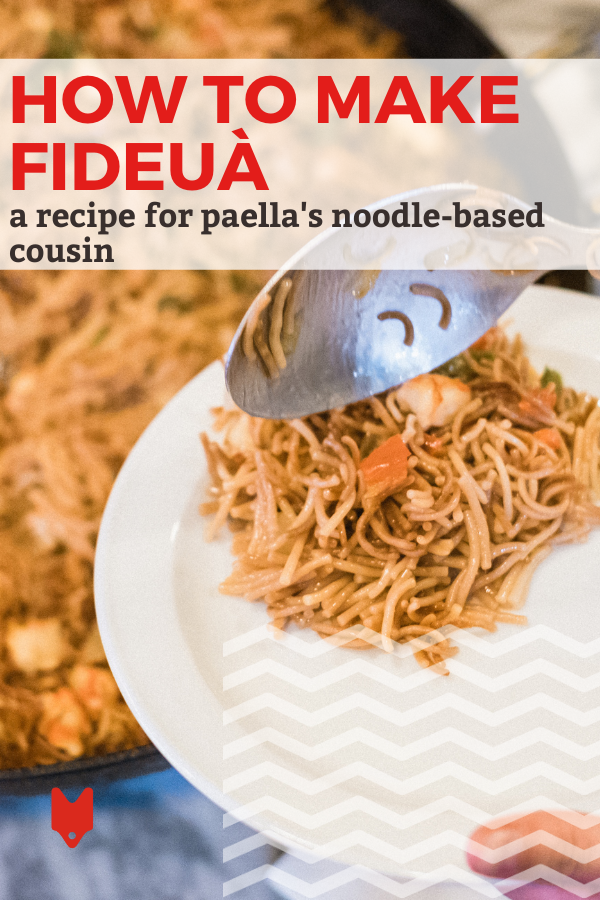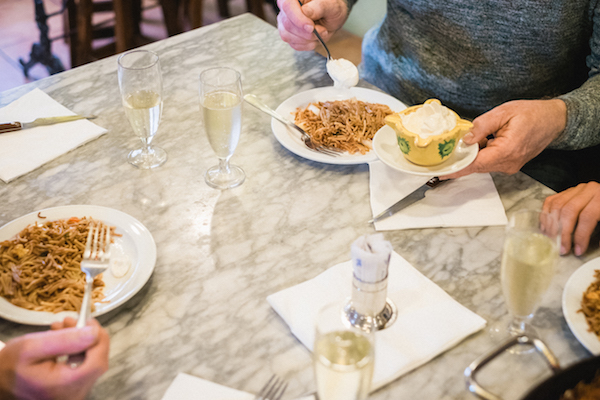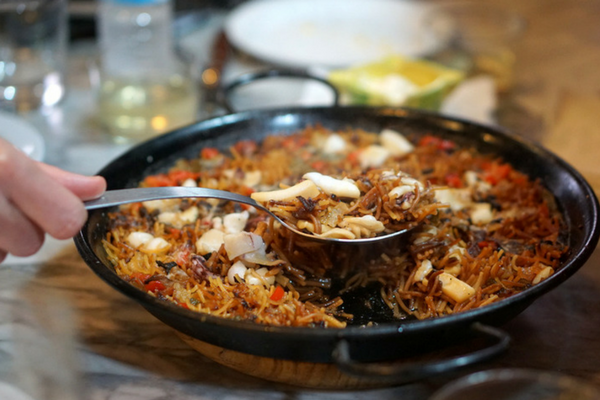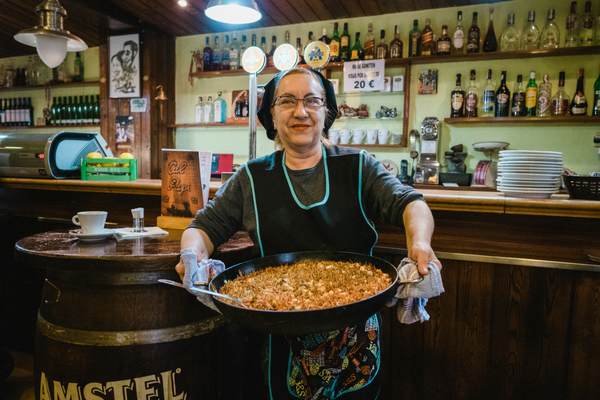This blog post was originally posted on March 9, 2016, and was updated on September 8, 2020.
Everyone’s heard of paella—but what about its noodle-based cousin, fideuà? Try making it yourself with this fideuà recipe.
This recipe comes from one of our favorite people in Barcelona: Mama Carmen, whose small seaside restaurant Cal Papi was a local institution for decades. Though Cal Papi sadly closed down when Carmen retired in 2019, her famous fideuà recipe lives on!

Fideuà vs. paella
The important difference between fideuà and paella is the main ingredient. In paella, this is, of course, rice.
On the other hand, fideuà gets its name from the word fideos. This is the small, vermicelli-type noodle that replaces the rice in fideuà.
Unlike paella, there are no chicken and rabbit-based, or vegetarian fideuàs; they all revolve around seafood. Add a healthy dollop of garlic alioli (another addition never found in paella) and fideuà is perfection on a plate.

But the two dishes have a lot in common, the first being that both paella and fideuà are typically eaten at lunch. They’re both heavy and hearty dishes that fill you up, and since lunch is the biggest meal of the day here in Spain, you’ll have plenty of time to digest it and get energized for the rest of your day. Eating paella or fideuà for dinner is basically unheard of.
The fascinating history of fideuà
Legend says that the very first fideuà was actually supposed to be a seafood paella! As the story goes, the dish was born in the early 20th century on board one of the fishing vessels that sailed out from Gandia, in Valencia, every morning.
The cook on board this particular ship went to prepare a seafood paella for the crew for lunch. Only after starting the sofrito did he realize, to his horror, that there was no rice on board the boat! Thinking quickly, he continued making the recipe to avoid wasting what he’d already made, and simply replaced the rice with small noodles (fideos).
A similar version of the story alludes to a greedy captain who wanted the cook’s delicious paella all for himself, so the cook had no other option but to whip up something else for the crew, and thus used the noodles instead of rice in a similar dish. Whichever version of the story you believe, they both end with delicious results, and fideuà has been a staple of Valencian and Catalan cuisine ever since.

Fideuà today
Nowadays, fideuà is one of the classics of Catalan cuisine. You’ll find it at plenty of traditional restaurants in Barcelona, but it’s at its best in the seaside Barceloneta neighborhood. This traditional fishing barrio has changed a bit over the years, but still retains much of its classic essence, especially in the food—much of which is prepared with seafood caught the same day just a few blocks away.
Maybe you can’t make it to Barcelona right now. Or maybe you’ve already come, and can’t stop thinking about the rich, savory flavors of that fideuà. We understand your struggle, so we asked our friend Carmen for her fideuà recipe.
One of the most important ingredients, Carmen insists, is something you can’t buy at any market—lots of love.
Mama Carmen’s fideuà recipe

Prep time: 30 minutes
Cook time: 1 hour 30 minutes
Total time: 2 hours
Serves: 4
Ingredients
- 1 large red pepper, chopped
- 1 green pepper, chopped
- 1 medium onion, chopped
- 3 tomatoes, pureed
- 14 oz (400 grams) fideos or short vermicelli noodles
- 8 oz (250 grams) cuttlefish, cleaned and chopped
- 8 oz (250 grams) raw shrimp, peeled and deveined
- 3 cups hot fish stock
Instructions
- Heat extra-virgin olive oil over medium heat in a paella pan or another large, shallow pan.
- Add the onions and peppers and simmer for at least 30 minutes (no more than 1 hour), until tender and translucent.
- In a separate pan, lightly toast the noodles until golden brown.
- Add the cuttlefish and shrimp to the simmering vegetables. Add the noodles.
- Heat up the fish stock and add it to the pan, making sure all ingredients are just covered with liquid, and turn the heat up to high.
- Bring to a boil, then lower the heat and cook on medium-low until all the liquid has been absorbed.
- Serve with alioli and enjoy!
Fideos is the main ingredient and there’s no quantity given in the recipe! Fideo packages come in different sizes in different countries.
Oops, good catch! Around 300g of fideos will work here.
Exactly when do you add the tomato purée?
You can add it with the onions and peppers so the vegetables simmer all together!
Honestly, this is too complicated. You shouldn’t need to know HOW many grams, ounces… just the ration of water to rice/orzo/fideos.. and make sure you know your rice. I’ve used all kinds from Jasmine, Japanese long grain to Italian and Bomba!
Remember, this is an attitude. Like Luke, you must follow the Force. Recipes don’t cut it.
When I make my paellas I may switch orzo or fideos, just adjust the water and keep an eye on the pot.
I may use my paellera, or a deep dish cast iron pan. Sometimes outdoor on the big propane ring but most often indoor on our Viking range with its big burners ( you Do have to have BIG burners to use the paellera but the big cast iron deep skillet works great ).
BTW, here’s a real trick. Use Japanese Hondashi. It gives it the flavor of the fish stock without having to go all the hassle of the cooking and it makes the whole thing much faster and still very good tasting.
Remember, paellas are a style of cooking. There are no real recipes except you need saffron and must cook the rice on the sofrito before you add the water. I also use smoked paprika, because my grand mother and some of my aunts used it and I like the taste.
And whatever you do, don’t forget the wine. As Julia Child once said.. “I use lots of wine when I cook, sometimes I use it on the food”… 😉
Sounds like you have a great system—all your ingredients sound like they would make for a delicious paella! Thanks for sharing, Tony!